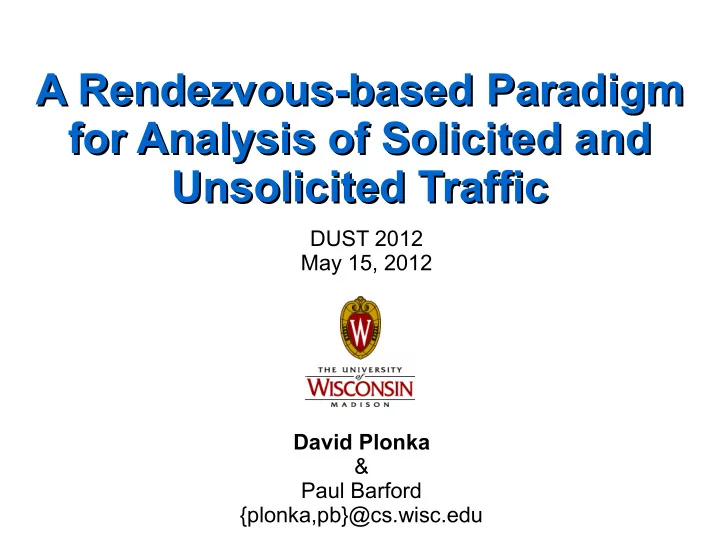

A Rendezvous-based Paradigm A Rendezvous-based Paradigm for Analysis of Solicited and for Analysis of Solicited and Unsolicited Traffic Unsolicited Traffic DUST 2012 May 15, 2012 David Plonka & Paul Barford {plonka,pb}@cs.wisc.edu
Outline ● Rendezvous-based Traffic Analysis – What is it? Why use it? – a DNS rendezvous case study involving office and residential “solicited” traffic ● Darkspace Rendezvous Mechanisms – unsolicited and passively solicited traffic ● TreeTop – a DNS rendezvous-based analysis tool [Plonka & Barford, IMC 2009, SATIN 2011, work in progress] – flow export with rendezvous annotations – IPv6 performance by service names
Rendezvous-based Traffic Analysis? ● Traffic classification and analysis has focussed on target traffic features (IP headers, DPI, etc.) ● However, Internet hosts learn IP addresses by some rendezvous mechanism, e.g.: – By static configuration (IP addrs in config files) – The Doman Name System (DNS) – Application-specific mechanisms (URLs, p2p) ● Inform traffic analysis by considering, “How does this host know this IP address?” rather than simply, “With what IP address did this host interact?”
Why Focus on Rendezvous? rendezvous, meaning hosts and services “present themselves” ● For standard protocols, rendezvous information is not private and is of low-volume – Separate and separable from private payloads – Can be monitored in situations where target traffic is high-volume, sampled, or encrypted ● Rendezvous info can indicate when other analysis or classification techniques are effective and not – e.g., port-based classification [Kim, et al., 2008] [Plonka & Barford, 2011]
Rendezvous-based Traffic Classification rendezvous, meaning “present yourselves” ● Hypothesis : We can inform and improve traffic classification by considering, “How does this host know that peer IP address?” ● DNS : Internet hosts regularly use the DNS to find remote IP addresses of the hosts with which they might interact. – It is an easily separable standard, “clear text” protocol.
DNS Rendezvous: (1) Query DNS Overview
DNS Rendezvous: (2) Response DNS Overview
DNS Rendezvous: (3) Outbound DNS Overview
DNS Rendezvous: (4) Inbound DNS Overview
Traffic Observation Points DNS Overview
Traffic Observation Points DNS Overview
Traffic Observation Points DNS Overview
Traffic Observation Points DNS Overview
Characteristics of Data Sets
Target Traffic Classification: Port-based method
Residential: Domain Popularity
Office Target Traffic Classification: “named” and “unnamed”
Residential Target Traffic Classification: “named” and “unnamed”
Residential Target Traffic Classification: “named” by popular domains
Host Profiling and Reputation based on Rendezvous Information
Residential Hosts Classification by P2P Host Profile (1 day)
“unnamed” Target Traffic by P2P Profile
Results Summary: Traffic Classified (% bytes)
Rendezvous in Darkspace/Grayspace? ● Darkspace and Unsolicited : a host uses some technique to choose remote/peer IP addresses – Algorithm , e.g., scanning a contiguous set of IP addresses in series, choosing IP addresses at random – Bug , e.g. D-link products connect to 45.52.84.48, the 7-bit string “-4T0”, believed to be a stray value left in an uninitialized 32-bit integer meant to store an SMTP server's IP address [Yegneswaran, Barford, Plonka, 2004] – Misconfiguration or stale configuration, e.g., SNMP traps to various 45/8 addresses from Interop events – IP prefixes become encumbered by legacy roles
TreeTop: Rendezvous-annotated Flow Export
TreeTop: radix tries and domain trees
[3 private slides redacted]
Discussion ● In what circumstances can we trust rendezvous information for traffic classification or host profiling/reputation? ● Tap rendezvous methods other than the DNS; e.g., application-specific methods (WWW, P2P); are they discoverable, separable and clear? ● Should we alter or invent rendezvous protocols to better inform classification and packet treatment? ● Is rendezvous a useful unifying analysis concept?
A Rendezvous-based Paradigm A Rendezvous-based Paradigm for Analysis of Solicited and for Analysis of Solicited and Unsolicited Traffic Unsolicited Traffic FIN David Plonka & Paul Barford {plonka,pb}@cs.wisc.edu
Recommend
More recommend